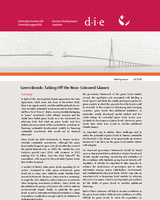Green bonds: taking off the rose-coloured glasses
Berensmann, Kathrin / Florence Dafe / Miriam Kautz / Nannette LindenbergBriefing Paper 24/2016
Bonn: German Development Institute / Deutsches Institut für Entwicklungspolitik (DIE)
Dt. Ausg. u.d.T.:
Grüne Anleihen: ohne rosarote Brille betrachtet
(Analysen und Stellungnahmen 7/2017)
In light of the recent global climate agreement, the Paris Agreement, which came into force in November 2016, there is an urgent need to mobilise additional funds for environmentally sustainable investments and to direct financial flows from “brown”, that is, environmentally damaging, to “green” investment. Public officials, investors and the media have hailed green bonds as a key instrument for achieving both. But what are green bonds, and how realistic are assessments of their potential to contribute to financing sustainable development, notably by financing sustainable investments that would not be financed otherwise?
Green bonds are debt instruments to finance environmentally sustainable investments. Although the green bond market began to grow only slowly after the onset of the global financial crisis in 2008, the market has seen explosive growth since 2014, with issuances in 2015 reaching USD 42 billion. Since the 2014 ”take-off”, the expectations with respect to the potential of green bonds have further increased.
A number of factors make green bonds appealing for investors. Compared to other green instruments, green bonds are in many cases relatively simple, familiar fixed-income instruments. Moreover, many investors increasingly weigh the risks related to carbon-intensive investments when designing investment portfolios. Green bonds are also attractive for groups of investors who wish to make an environmental impact. Finally, in particular the green bonds issued by international financial institutions or large corporations usually have enough scale to be attractive to institutional investors.
There are, however, also a number of challenges in relation to green bonds. These include: first, deficiencies of the governance framework of the green bond market; second, the significant costs associated with labelling a bond “green”; and third, the weakly developed pipeline for green projects in which the proceeds from the bonds could be invested. In the context of developing and emerging countries, green bonds face additional limitations. In particular, weakly developed capital markets and low credit ratings for potential green bond issuers pose obstacles to the issuance of green bonds. Moreover, green bonds have rarely been issued to mobilise additional climate finance.
An important way to address these challenges and to realise the potential of green bonds to finance sustainable development is the design of an appropriate governance framework. Only then can the green bond market mature with integrity.
An improved governance framework should be based upon a clear and ambitious definition of green bonds and include regular reporting, monitoring and evaluation of the compliance with standards, going beyond industry self-regulation. It will also be important to take measures to enhance the inclusiveness of governance and to share information among various stakeholders. Governments and multilateral development banks (MDBs) may play an important role in deepening bond markets by reducing the costs of issuance, which is an important precondition for the ability of green bonds to mobilise additional financing.
Each of these measures will help to increase confidence in the green bond market. Without such confidence, it will be difficult for green bonds to meet the expectation to mobilise additional funds for environmentally sustainable investments and to direct financial flows from brown to green investments.




